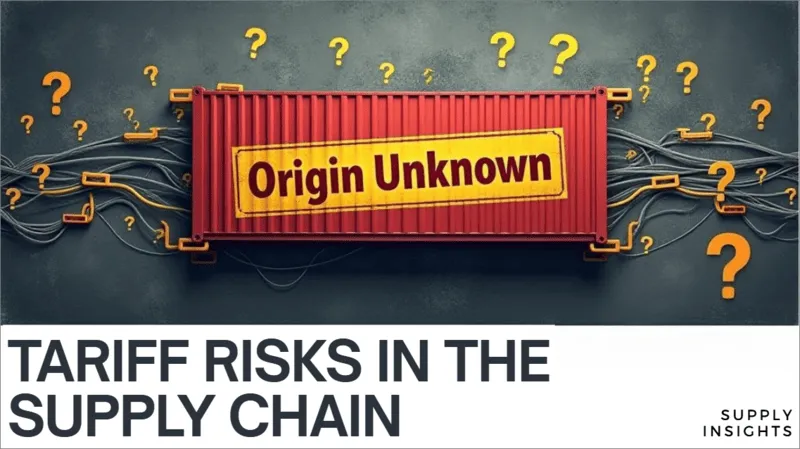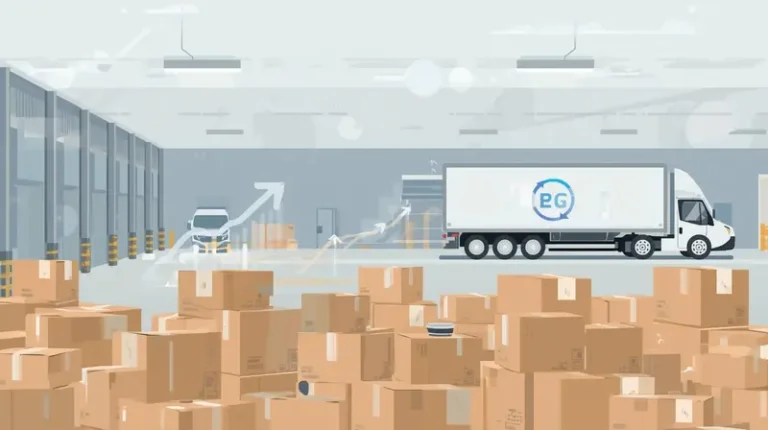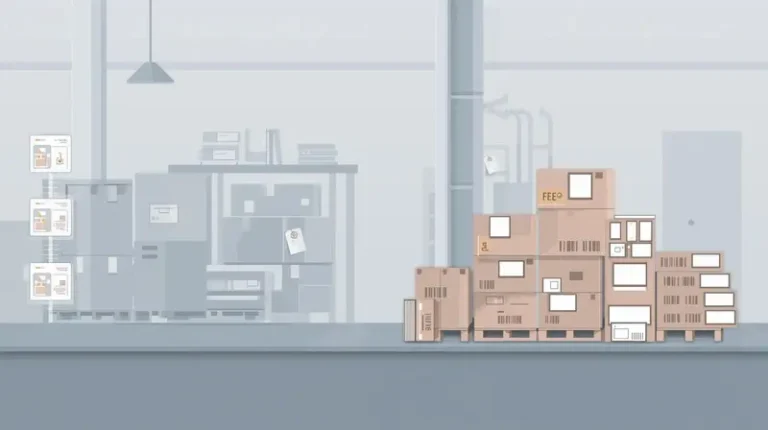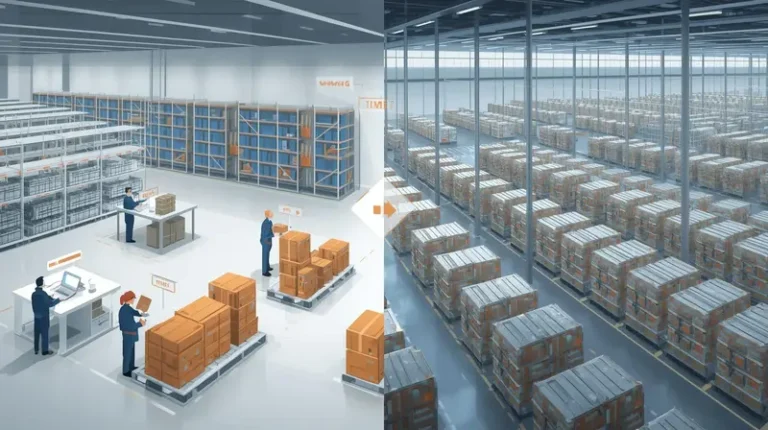Transshipment Rules Are a Time Bomb: The Tariff You Didn’t See Coming

Last updated on August 15, 2025

In this article
 10 minutes
10 minutes
- Transshipment Isn’t Just a Logistics Term, It’s a Tariff Time Bomb
- Opaque Supply Chains Used to Save You Money. Now They’ll Sink It.
- Mid-Size Brands Are Especially Vulnerable
- The Role of Container Ports in Transshipment and Tariff Exposure
- The Way Out: Transparency, Contracts, and Smart Logistics Tools
- Why It Matters Now More Than Ever
- Quick Tactical Takeaways
- Frequently Asked Questions
Guess what’s lurking beneath the surface of your shipping labels? Transshipment. It sounds nerdy, right? But when rules of origin are murky and Customs gets laser-focused, it’s not cute, it’s a margin-eating monster.
If you’re not 100% sure where each component of your product comes from, you’re basically flying blind. And when Customs flips the switch, that’s a full-blown tariff grenade at the port. The main reasons for transshipment include tariff avoidance, navigating trade sanctions, and regulatory monitoring. The unloading and loading of goods at ports is a key step in the transshipment process, involving the transfer of cargo between vessels or containers at designated hubs, which can trigger customs scrutiny.
Slash Your Fulfillment Costs by Up to 30%
Cut shipping expenses by 30% and boost profit with Cahoot's AI-optimized fulfillment services and modern tech —no overheads and no humans required!
I'm Interested in Saving Time and MoneyTransshipment Isn’t Just a Logistics Term, It’s a Tariff Time Bomb
Transshipment refers to shipping goods that are routed through a third country, like Vietnamese imports shipped to the U.S. but containing Chinese fabric, rather than taking a direct route from origin to destination.
The main difference between transshipment and direct shipment is that transshipment involves transferring goods at a transshipment hub when there is no direct route between the export and import locations. In direct shipment, cargo moves straight from the origin to the final destination without being transferred at an intermediate point.
During transshipment, cargo is unloaded from one ocean vessel and loaded onto another at a transshipment hub, often remaining in the same container, to continue its journey to the final destination. For example, at major ports like Singapore, containers are transferred between vessels to optimize transport and logistics operations. The process involves coordination between carriers, shippers, and importers to ensure efficient transportation and compliance with trade regulations. Transloading refers to transferring goods between different forms, such as the form of container or type of transportation, or modes of transportation, such as switching from ship to road or rail. Transshipment typically keeps the cargo in one form, like the same container, between ocean vessels, while transloading may involve changing from one form to another or switching between different modes.
When Customs deems that suspicious, they tack on a 40% surcharge on top of base tariffs (that’s in addition to any applicable duties), with no appeals, no mercy.
Here’s the kicker: the legal definition of “substantial transformation” is fuzzy. Just slapping a Made-in-Vietnam label on a Chinese-made textile doesn’t cut it. Customs scrutiny is stepping up; Thailand, for instance, is using X-ray checks, audits, and documentation reviews to catch origin washing in action.
So yeah, transshipment = hidden margin risk. And it always hits mid-sized brands harder,
Opaque Supply Chains Used to Save You Money. Now They’ll Sink It.
Opaque supply chains were once efficient for cost-saving. But today? That’s a liability.
Think about it: you buy from a 3PL that bundles sourcing and logistics. You care about shipping costs, not the origin of every bolt. Well, that blind trust just turned into a potential freight bomb.
Customs isn’t playing nice. The Justice Department now treats customs misclassification with the same zeal as fraud. We’re talking treble damages, wire-fraud investigations, and serious exposure, possibly even smuggling charges.
It’s a hyper-complicated supply chain world. And if you don’t know where components are born, fabric from China, buttons from HK, assembly in Vietnam, and whether those parts were legally “substantively transformed”? You’re at risk.
Mid-Size Brands Are Especially Vulnerable
Big retailers and brands have legal teams and supply chain visibility tools. They can trace components, demand origin attestation, enforce vendor compliance, and model scenarios. But mid-size brands? They often lack the software, budget, or legal buffer. So they rely on faith and generic contracts.
Three consequences:
- Forecasting chaos. You price for a 20 – 30% tariff, but Customs slaps on 40% for a hazy origin. Boom, there goes your Q4 margin.
- No runway. Hitting port with a surprise duty means freight delays, a scramble for funds, and angry logistics partners.
- Zero recourse. Customs’ anti-transshipment rules are non-negotiable. The penalty’s automatic. No appeals.
Social media won’t fix this margin hit. A traceability-first logistics strategy will.
Looking for a New 3PL? Start with this Free RFP Template
Cut weeks off your selection process. Avoid pitfalls. Get the only 3PL RFP checklist built for ecommerce brands, absolutely free.
Get My Free 3PL RFPThe Role of Container Ports in Transshipment and Tariff Exposure
Container ports are the beating heart of global trade, acting as transshipment hubs where the world’s cargo changes hands, vessels, and sometimes even continents. When it comes to shipping goods internationally, the main difference between direct shipments and transshipments comes down to the journey: direct shipments travel straight from the origin to the final destination on one vessel, while transshipments involve unloading containers at a transshipment port, then reloading them onto another vessel for the next leg of the trip.
Why does this matter? Because container ports, especially the busiest ports in regions like Hong Kong, South Korea, and China, are designed to accommodate massive volumes of cargo, from smaller shipments to full container loads. These ports consolidate goods from multiple countries, allowing shippers to combine smaller shipments into larger vessels, which slashes shipping costs and streamlines the supply chain. It’s a process that keeps global trade humming, making it possible to move goods efficiently between countries, even when there’s no direct route.
But here’s the catch: container ports are also where tariff exposure can spike. When trade policies shift, like during the Trump administration’s tariff hikes on imports from China, shipping costs can soar, and the demand for transshipment services can shift overnight. Importers and exporters may reroute shipments through alternative transshipment hubs or ports in other countries to dodge tariffs, but this can trigger customs scrutiny and increase the risk of penalties if the origin of goods becomes unclear.
Despite these challenges, container ports remain essential. They offer a full suite of transshipment services, from intermodal transportation to advanced cargo handling, ensuring that containers are efficiently transferred, tracked, and delivered to their final destination. The world’s major ports are constantly adapting, investing in technology and infrastructure to handle everything from bulk cargo to specialized equipment, keeping the global supply chain resilient even as trade patterns evolve.
In short, container ports are more than just points on a map; they’re strategic assets in the battle to control shipping costs, manage tariff exposure, and keep goods moving across borders. For shippers, importers, and logistics professionals, understanding how these ports operate and how transshipments differ from direct shipments can make all the difference in navigating today’s complex world of international trade.
The Way Out: Transparency, Contracts, and Smart Logistics Tools
Here’s what forward-thinking brands are doing, some already doing quietly, but more are waking up:
- Push tariff liability upstream. Vendor contracts now include clauses: “If Customs says your origin was misrepresented, you cover the penalty.” Pressure aligns your supplier to do due diligence.
- Track supply at the component level. Not just finished SKU. From fabric mill to button jobber to assembly plant. Build an efficient supply chain with an origin-aware logistics process.
- Smaller, smarter shipments. Instead of one big purchase order stuffed into one vessel, go smaller. Split across nodes and diversify shipments across different regions, so if one shipment gets flagged, you’re not bleeding 40% on your entire batch.
- Use traceability and routing tools. Visibility of your supply chain, origin tagging, and route logic that flags risk early, helps steer around flagged origins before dockside disasters. These tools support business accounts and provide access to advanced equipment for tracking and handling cargo, including tracking shipment dates to ensure timely delivery and compliance.
Leading logistics providers offer transshipment services and intermodal transportation solutions to optimize supply chains and reduce risk, with a focus on key regions and sea routes. Japan stands out as a major destination and hub in international shipping and transshipment, highlighting the importance of strategic maritime connections in global logistics.
Because at the end of the day, most shipping platforms stop once the label’s printed. But when a 40% tariff surprise pops at the port, you can’t ask, “Where did that component come from?” Cost control starts at the origin.
Why It Matters Now More Than Ever
- Tighter enforcement: CBP is stepping up. They’ll publish lists of suspected facilities, they’re collaborating internationally, and they’re using audits and tech to sniff origin laundering. Increased scrutiny impacts international trade and the flow of goods across borders, potentially causing delays and disruptions in transshipment activities, especially when congestion at the final port leads to further holdups.
- Unclear definitions, but strict penalties: The rules of origin are still vague, but penalties are crystal clear and stiff. Goods transported between ports are subject to strict regulatory oversight, increasing compliance risks.
- Cost of waiting? Massive margin erosion: If you launch a holiday collection, then Customs slams it with an unexpected 40% tariff, game over.
- Customers can’t wait: Same-day delivery expectations, seamless logistics operations, customer satisfaction, all crumble when origin surprises slow things down. Meeting promised delivery dates is crucial to maintain customer satisfaction and trust.
Scale Faster with the World’s First Peer-to-Peer Fulfillment Network
Tap into a nationwide network of high-performance partner warehouses — expand capacity, cut shipping costs, and reach customers 1–2 days faster.
Explore Fulfillment NetworkQuick Tactical Takeaways
- Trace every component: suppliers must prove origin with documentation for both imports and exports.
- Add liability clauses, shifting risk to the supplier.
- Send in smaller shipments via multiple transshipment ports in different regions to diversify risk, not one massive container. Avoid relying on one port for all shipments, as this increases vulnerability to disruptions. Consider using different ships to further diversify your shipping strategy. Smaller vessels can be used to transfer containers from local ports to larger ships at transshipment hubs, improving flexibility and efficiency.
- Use visibility tools to monitor origin, routing, and compliance.
- Model scenarios with Customs risk baked in: what’s your fallback if one supplier gets flagged?
Frequently Asked Questions
What is a transshipment tariff?
Transshipment refers to the process of transferring goods between different ships or modes of transport. Transshipment penalties are extra duties, typically 40%, imposed when U.S. Customs determines products were transferred between vessels or ships at transshipment hubs to obscure their true origin and evade higher tariffs. Goods that are transported through such hubs and involve the transfer between ships may trigger these penalties. Penalties can be even more severe if Customs determines that illegal transshipments were used to conceal the true origin of goods. These penalties stack on top of base tariffs and leave zero room for negotiation.
How do rules of origin affect tariffs?
Customs determines origin based on “substantial transformation”, where the product’s nature changes. Simply assembling or labeling isn’t enough. Misrepresenting origin, especially with components from high-tariff countries, risks transshipment violations.
It’s important to distinguish between transshipment and transloading. Transshipment typically involves transferring goods between ships or other transport at a hub while keeping them in one form, such as the same container, and often within the same mode of transportation. In contrast, transloading may involve moving goods from one form to another, such as transferring cargo between different types of containers or switching between transportation modes (e.g., from ship to road). Both exporters and importers must ensure accurate export documentation and compliance, as importers attempting to manipulate or hide information can face strict penalties at transshipment hubs monitored by customs authorities.
Are smaller brands more at risk?
Yes. Mid-sized brands often lack deep compliance systems and legal firepower. They’re more likely to rely on opaque supply chains and risk surprise penalties with zero recourse or runway. Shippers, in particular, must also be vigilant about supply chain transparency to avoid unexpected penalties.
Why send smaller shipments instead of big POs?
Smaller, frequent shipments reduce exposure risk. If one shipment gets flagged, you minimize total margin loss. Plus, it allows flexibility in redirecting supply if certain components come under audit or Customs scrutiny. Additionally, using a smaller vessel for certain routes can provide extra flexibility and help avoid congestion at major ports.
&npsp;

Turn Returns Into New Revenue





